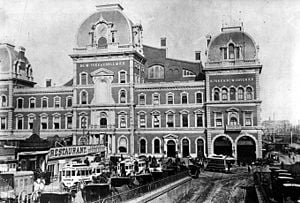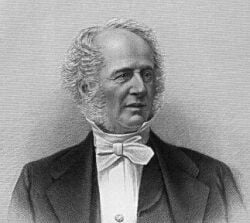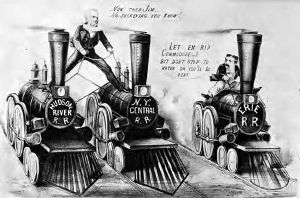Cornelius Vanderbilt
Cornelius Vanderbilt I (May 27, 1794 – January 4, 1877) was an American entrepreneur who built his wealth in shipping and railroads and was the patriarch of the Vanderbilt family. In later life he was known as Commodore Vanderbilt.
Early life
Vanderbilt was the fourth of nine children born in Port Richmond on Staten Island in New York City to Cornelius Vanderbilt and Phebe Hand, a family of modest means. His great-great-great-grandfather, Jan Aertson, was a Dutch farmer from the village of De Bilt in Utrecht, the Netherlands, who emigrated to New York as an indentured servant in 1650. The Dutch "van der" (of the) was eventually added to Aertson's village name to create "van der bilt," which was eventually condensed to Vanderbilt. Most of Vanderbilt's ancestry was English, with his last ancestor of Dutch origin being Jacob Vanderbilt, his grandfather.[1]
On December 19, 1813, Cornelius Vanderbilt married his cousin and neighbor, Sophia Johnson (1795-1868), daughter of his mother's (Phebe Hand Vanderbilt) sister (Elizabeth Hand Johnson). He and his wife had 13 children, one of which, a boy, died young.
Ferry empire
As a young boy, Cornelius Vanderbilt worked on ferries in New York City, quitting school at age 11. By age 16 he was operating his own business, ferrying freight and passengers between Staten Island and Manhattan.
<left>
| If I had learned education, I would not have had time to learn anything else. —Cornelius Vanderbilt |
During the War of 1812, he received a government contract to supply the forts around New York City. He operated sailing schooners, which is where he gained his nickname of "commodore."
In 1818, he turned his attention to steamships. The New York legislature had granted Robert Fulton and Robert Livingston a thirty-year legal monopoly on steamboat traffic. That is, competition was forbidden by law. Working for Thomas Gibbons, Vanderbilt undercut the prices charged by Fulton and Livingston for service between New Brunswick, New Jersey, and Manhattan—an important link in trade between New York and Philadelphia. He avoided capture by those who sought to arrest him and impound the ship. Livingston and Fulton offered Vanderbilt a lucrative job piloting their steamboat, but Vanderbilt rejected the offer. He said "I don't care half so much about making money as I do about making my point, and coming out ahead." For Vanderbilt, the point was the superiority of free competition and the evil of government-granted monopoly.[1] Livingston and Fulton sued, and the case went before the United States Supreme Court and ultimately broke the Fulton-Livingston monopoly on trade.
In 1829, he struck out on his own to provide steam service on the Hudson River between Manhattan and Albany, New York. By the 1840s, he had 100 steamships plying the Hudson and was reputed to have the most employees of any business in the United States.
During the 1849 California Gold Rush, he offered a shortcut via Nicaragua to California—shaving 600 miles (960 km) at half the price of the Isthmus of Panama shortcut.
Rail empire
Early rail interest
<left>
| You have undertaken to cheat me. I won't sue you, for the law is too slow. I will ruin you. —Cornelius Vanderbilt, 1853 - in a letter to a former business associate. |
Vanderbilt's involvement with early railroad development led him into being involved in one of America's earliest rail accidents. On November 11, 1833, he was a passenger on a Camden & Amboy train that derailed in the meadows near Hightstown, New Jersey when a coach car axle broke because of a hot journal box. He spent a month recovering from injuries that included two cracked ribs and a punctured lung. Uninjured in this accident was former U.S. President John Quincy Adams, riding in the car ahead of the one that derailed.[2]
In 1844, Vanderbilt was elected as a director of the Long Island Rail Road, which at the time provided a route between Boston and New York City via a steamboat transfer. [3] In 1857, he became a director of the New York and Harlem Railroad. [4]
New York Central Railroad
In the early 1860s, Vanderbilt started withdrawing capital from steamships and investing in railroads. He acquired the New York and Harlem Railroad in 1862-63, the Hudson River Railroad in 1864, and the New York Central Railroad in 1867. In 1869, they were merged into New York Central and Hudson River Railroad.

Grand Central Depot
Main article: Grand Central Terminal
In October 1871, Vanderbilt struck up a partnership with the New York and New Haven Railroad to join with the railroads he owned to consolidate operations at one terminal at West 42nd Street called Grand Central Depot, which was the original Grand Central Terminal, where his statue reigns today. The glass roof of the depot collapsed during a blizzard on the same day Vanderbilt died in 1877. The station was not replaced until 1903-13.
Rivalry with Jay Gould
By 1873, he had extended the lines to Chicago, Illinois. Around this time Vanderbilt tried to gain control of the Erie Railroad, which brought him into direct conflict with Jay Gould, who was then in control of the Erie. Gould won the battle for control of the railroad by "watering down" its stock, which Vanderbilt bought in large amounts. Vanderbilt lost more than $7 million in his attempt to gain control, although Gould later returned most of the money. Vanderbilt was very accustomed to getting what he wanted, but it seems that he met his match in Jay Gould. Vanderbilt would later say of his loss " never kick a skunk." In fact this was not the last time that Gould would serve to challenge a Vanderbilt. Years after his father's death, William Vanderbilt gained control of the Western Union Telegraph company. Jay Gould then started the American Telegraph Company and nearly forced Western Union out of business. William Vanderbilt then had no choice but to buy out Gould, who made a large profit from the sale.
Vanderbilt legacy
After the death of his wife, Vanderbilt went to Canada where, on August 21, 1869, he married a cousin from Mobile, Alabama, Frank Armstrong Crawford. Ms. Crawford's mother was a sister to Phebe Hand Vanderbilt (the Commodore's mother) and to Elizabeth Hand Johnson (the Commodore's former mother-in-law and maternal aunt). Ms. Crawford was 43 years younger than Vanderbilt. It was her nephew who convinced Cornelius Vanderbilt to commit funding for what would become Vanderbilt University.
Ruthless in business, Cornelius Vanderbilt was said by some to have made few friends in his lifetime but many enemies. His public perception was that of a vulgar, mean-spirited man who made life miserable for everyone around him, including his family.[citation needed] He often said that women bought his stock because his picture was on the stock certificate. In his will, he disowned all his sons except for William, who was as ruthless in business as his father and the one Cornelius believed capable of maintaining the business empire. At the time of his death, Cornelius Vanderbilt's fortune was estimated at more than US$100 million. He willed US$95 million to son William but only US$500,000 to each of his eight daughters. His wife received US$500,000 in cash, their modest New York City home, and 2,000 shares of common stock in New York Central Railroad.
Vanderbilt gave little of his vast fortune to charitable works, leaving the US$1 million he had promised for Vanderbilt University and $50,000 to the Church of the Strangers in New York City. He lived modestly, leaving his descendants to build the Vanderbilt houses that characterize America's Gilded Age.
Descendants
Main article: Vanderbilt family
Cornelius Vanderbilt was buried in the family vault in the Moravian Cemetery at New Dorp on Staten Island. Three of his daughters and son Cornelius Jeremiah Vanderbilt contested the will on the grounds that their father had insane delusions and was of unsound mind. The unsuccessful court battle lasted more than a year, and Cornelius Jeremiah committed suicide in 1882.
Vanderbilt is the great-great-great grandfather of journalist Anderson Cooper.
Children of Cornelius Vanderbilt & Sophia Johnson:
- Phebe Jane (Vanderbilt) Cross (1814-1878)
- Ethelinda (Vanderbilt) Allen (1817-1889)
- Eliza (Vanderbilt) Osgood (1819-1890)
- William Henry Vanderbilt (1821-1885)
- Emily Almira (Vanderbilt) Thorn (1823-1896)
- Sophia Johnson (Vanderbilt) Torrance (1825-1912)
- Maria Louisa (Vanderbilt) Clark Niven (1827-1896)
- Frances Lavinia Vanderbilt (1828-1868)
- Cornelius Jeremiah Vanderbilt (1830-1882)
- Mary Alicia (Vanderbilt) LaBau Berger (1834-1902)
- Catherine Juliette (Vanderbilt) Barker LaFitte (1836-1881)
- George Washington Vanderbilt (1839-1864)
Trivia
| What do I care about law? Hain't I got the power? —Cornelius Vanderbilt |
- Some say that potato chips were invented after Native American chef George Crum grew tired of Vanderbilt's complaining about how his potatoes were too thick, too soggy, and not salty enough. Crum then decided to slice the potatoes as thin as possible and fried them, creating the first potato chips.
- In Atlas Shrugged, Ayn Rand roughly based her character, Nat Taggart, on Cornelius Vanderbilt.
See also
- Railroads controlled by Vanderbilt
- New York and Harlem Railroad (1863-)
- Hudson River Railroad (1864-)
- New York Central Railroad (1867-)
- Canada Southern Railway (1873-) [5]
- Lake Shore and Michigan Southern Railway (1873?-)
- Michigan Central Railroad (1877-) [6]
- New York, Chicago and St. Louis Railroad (Nickel Plate Road) (1882-)
- West Shore Railroad (1885-)
- Rome, Watertown and Ogdensburg Railroad
- Mohawk and Malone Railroad
- Fall Brook Railway
- Beech Creek Railroad
- Dunkirk, Allegheny Valley and Pittsburgh Railroad
- Cleveland, Cincinnati, Chicago and St. Louis Railway
- Lake Erie and Western Railroad
- Pittsburgh and Lake Erie Railroad
ReferencesISBN links support NWE through referral fees
- Burton W. Folsom, Jr., The Myth of the Robber Barons, Young America.
- Robert Sobel The Big Board: A History of the New York Stock Market (1965) reprinted Beard Books (May 2000) ISBN 1-893122-66-2
Credits
New World Encyclopedia writers and editors rewrote and completed the Wikipedia article in accordance with New World Encyclopedia standards. This article abides by terms of the Creative Commons CC-by-sa 3.0 License (CC-by-sa), which may be used and disseminated with proper attribution. Credit is due under the terms of this license that can reference both the New World Encyclopedia contributors and the selfless volunteer contributors of the Wikimedia Foundation. To cite this article click here for a list of acceptable citing formats.The history of earlier contributions by wikipedians is accessible to researchers here:
The history of this article since it was imported to New World Encyclopedia:
Note: Some restrictions may apply to use of individual images which are separately licensed.
- ↑ Hull, Gary. The Abolition of Antitrust, Transaction Publishers, 2005, p. 77

